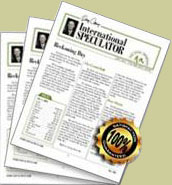 Casey Files: Casey Files:
Asia's Golden Age
Doug Casey
The International
Speculator
Jun 11, 2007
I am often asked by subscribers
to our International
Speculator why I'm so sure the economy of China is going
to continue on a roll, in turn keeping demand high for commodities
in general, and precious metals in particular.
Rather than going through the
macro-economics, I tend to abbreviate by referencing China's
troubled history, and pointing out that China's leadership, which
today are communist only in rhetoric, are well aware that they
are an anachronism. Which is to say that a serious slowdown in
the economy, with its attendant mass unemployment, could quickly
turn into a terminal event... politically and maybe even personally.
So they'll do what they must to keep the economy humming along.
And that is to continue to benefit from the lessons so clearly
learned in Hong Kong... first and foremost, staying out of the
way of the market.
Put another way, now that the
capitalist genie - or, more correctly, 1.3 billion genies - is
out of the bottle, there's no soft way of going back.
As David Galland points out
in the article that follows, the best way to take advantage of
China's explosive growth comes from getting positioned in gold
(and for leverage, gold
stocks)... the cultural default for wealth in Asia. As you'll
read, the signs of China's new golden age are already starting
to appear.
-Doug Casey
 Asia's Golden Age Asia's Golden Age
More straws in the wind for
gold... a wind coming out of the East.
On March 29 the Tokyo Commodity
Exchange (Tocom), the world's fourth-largest commodity futures
exchange, announced the loosening of margins to allow greater
daily price fluctuations for gold. The move broadens the range
by 33% as of April 1.
But it was not only what they
did but what they said that caught our attention. According to
Bloomberg, Shigeharu Amari, the general manager of Tocom's public
relations department, said that "Heightened demand for gold
in China and India have led to major swings in bullion prices
over the past six months, which is why we decided to make the
change."
China's traditional cultural
affection for gold, understandable given that country's troubled
history, was suppressed by Mao and company for 52 years, until
the liberalization of gold ownership in 2001.
Today, that affection for gold
is being stoked even hotter by concerns over a falling dollar
and a pig. Actually, the rumor of a pig. In the Chinese lunar
calendar, 2007 is the "year of the red pig," purportedly
a very auspicious year. Better yet, it is also widely rumored
to be the "Year of the Golden Pig," which, according
to fortunetellers, only comes around every 600 years.
The lunar calendar kicked off
on February 18, 2007, but even before the starting gun, the pick-up
in Chinese gold sales was apparent; in 2006, according to the
China Gold Association, gold consumption in that country grew
by 17%. Toss in a golden pig and things get a lot more interesting.
Even though the country's annual gold production is forecast
to reach 260 metric tonnes this year, it will fall about 100
tonnes short of meeting Chinese demand. The Shanghai Gold Exchange,
China's only precious metals trade platform, noted a gold trading
volume of nearly 130,000 kilograms in January, a rise of 72.83%
over the same period last year.
For the other great contender,
India, gold jewelry has historically played a crucial role--60%
to 70% of all jewelry is sold during the wedding and festival
season in October and November, and many Indian banks provide
loans for purchasing gold jewelry. Even though higher prices
have pushed gold jewelry sales down in 2006, most analysts now
see gold in India taking on a larger role as an investment for
the newly affluent looking to protect wealth (Indian inflation
is now running at 6.5%), versus just as body décor and
status.
Speaking of Indian investment,
on February 15, the first Indian gold ETF launched, the Gold
BeEs of Benchmark Mutual Fund. The second ETF launch, the UTI
Gold Exchange Traded Fund, is already underway. Rajesh Bhojani,
UTI Mutual Fund's president of marketing says about 30% of the
gold market in India is investors-and we suspect the new gold
ETFs are going to dramatically boost that percentage.
Hopping back to China, by now
anyone with any interest in gold is aware of the rock-and-hard
place dilemma caused by the 700 billion greenbacks now littering
China's official reserves. In 2006 alone, the Chinese took about
$3.4 billion in exchange rate losses ... chump change today,
but a clear warning shot of far bigger losses to come.
Diversifying out of the U.S.
dollar and into a far more diverse basket of assets, including
tangibles such as gold, has become a very high priority in China.
But yet, despite announcing last year that they were starting
a new government investment management corporation, the primary
purpose being to manage their towering reserves, the Chinese
don't seem to be in a big hurry to diversify. Well, maybe not
all is as it seems.
Chinese Checkers
Recently, the Chinese engaged
in a bit of carefully orchestrated theater, the purpose of which
was to reassure the world's financial community they were not
going to rock the boat in an attempt to diversify out of their
hundreds of billions of dollar reserves. The show kicked off
with Wen Jiabao, China's premier, assuring the market in a press
conference that China's new investment regime "would not
have any impact on U.S. dollar-denominated assets."
The opening act was followed
a few hours later by China's central bank when it pulled back
the curtain on a report stating that it wouldn't be making "frequent,
major adjustments to the structure of the reserves in response
to market movements."
But, switching analogies, let's
just suppose that the Chinese, rather than being poor chess players,
were actually pretty good at the game... and the bright young
team now being assembled to manage the diversification of China's
massive reserves were actually intent on their task?
Might the Chinese go out of
their way to reassure gullible markets that they weren't going
to be unloading dollars, when they actually were... getting rid
of as many greenbacks as possible before the broader markets
caught on? It is certainly within the realm of possibility. In
fact, if you look at it through the spectrum of a leadership
for whom the "Big Lie" has been an official policy
tool for better than half a century, it becomes downright likely.
That this may be the case is
made all the more apparent by the recent news that China had
invested $3.3 billion in Blackstone, the U.S. private equity
firm. You can rest assured that their investment strategy is
far more diverse than just investing in U.S. Treasury bills.
The global supply of gold is
already under pressure. From rising investor interest, helped
along with hugely popular new ETFs in the U.S. and London (among
others) and from the institutions and hedge funds now beginning
to recall that gold is a good portfolio asset. Throw onto the
scale the rising demand out of a booming Asia and the very real
possibility that the U.S. dollar has seen its best days, and
you have all the pressure you need to see gold heading much,
much higher from here.
How much higher? Impossible
to say, but it is worth noting that, on an inflation-adjusted
basis, gold would have to rise to $2,276 just to equal the previous
$850 high.
How you play the unfolding
gold market will depend on your psychology and temperament...
with your choices ranging from straight bullion on the tame side,
to the extreme leverage of futures on the wild. Around here at
Casey Research, we focus on the middle path; higher-quality gold
shares that, with some dedicated effort, can be well understood.
And if they can be understood, then the worst of the risk can
be eliminated, leaving mostly just the truly explosive upside.
Whatever approach you take,
however, just make sure that you don't procrastinate to the point
of missing the boat altogether.
The Golden Age is upon us.
David Galland
David Galland
is the managing editor of Doug Casey's International Speculator
newsletter,
now in its 27th year, dedicated to bringing investors unbiased
research on investments with the potential for 100% or better
returns over the coming 12-month period.
To learn more
about the International Speculator and a no-risk
trial subscription offering you the opportunity to view all the
International Speculator's current recommendations, click
here
now.
Doug Casey

Casey Archives
321gold Ltd

|